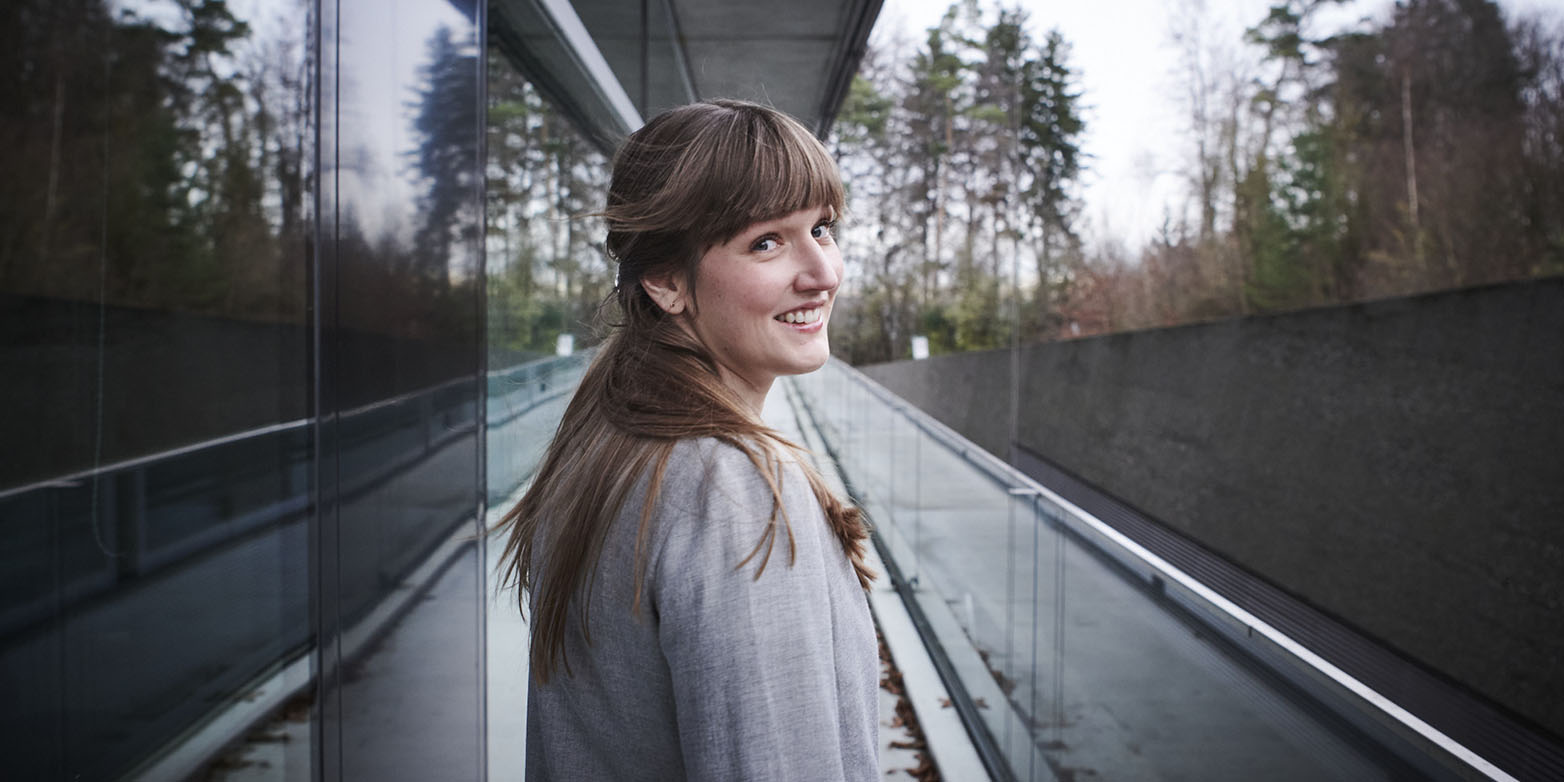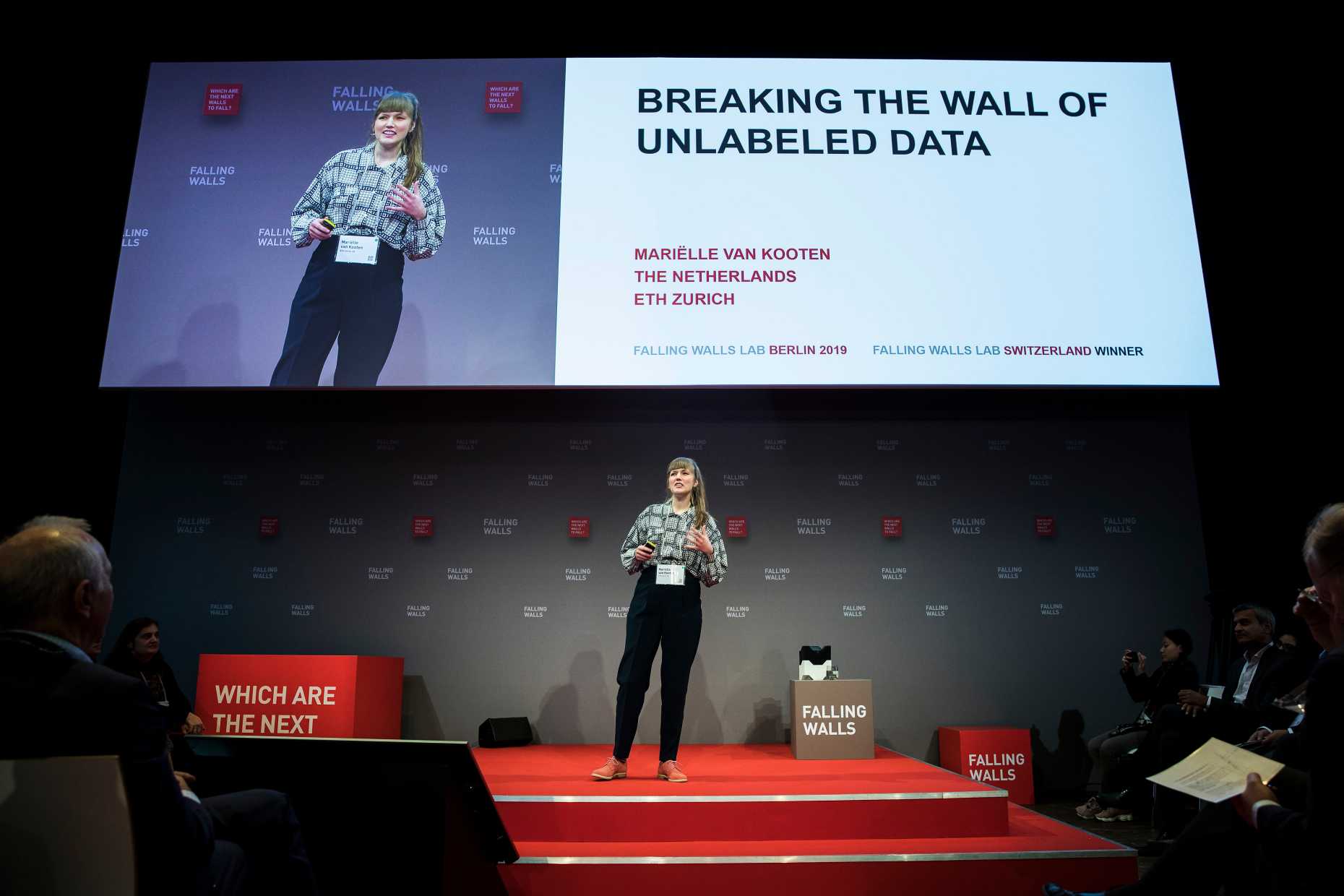From complex data to simple images
Mariëlle van Kooten’s ingenious idea won the ETH doctoral student second place in the international Falling Walls Lab in Berlin. She is developing an app that creates simple images from complex medical data. This makes it easier for the untrained eye to navigate the data jungle.

Mariëlle van Kooten feels quite at home on stage – that is obvious just a few seconds into her appearance at the Falling Walls Lab. She projects confidence and jokes with the audience, a style that is in tune with the project she is presenting. The ETH systems biologist wants to make something sexy that is actually completely unsexy: the analysis of vast quantities of complex genetic and medical data. Her goal here is to facilitate the early detection, prevention and treatment of diseases.
Van Kooten designed an app called SciSwipe during her doctoral studies in Beat Christen’s research group at ETH Zurich. This produces simple images from complex genetic data, which any non-specialist can also make sense of – van Kooten calls them “swipeable images”. These can be viewed on a smartphone, for example, and categorised merely by swiping. A simple yes or no – just like a dating app.
Van Kooten presented her idea on 8 November 2019 at the Falling Walls Lab in Berlin – an international competition where candidates explain their research work to a jury of experts from different specialist areas. However, they are only allowed two slides and three minutes to do so. Before the final conference in Berlin, knockout rounds were held at 90 locations worldwide, including the Start-up Night in Winterthur, Switzerland. 100 young scientists from 63 countries competed at the final conference. Van Kooten won second place.

Presenting key data characteristics in a simple way
Today the 32-year-old Dutch scientist sits at her desk in the Hönggerberg laboratory and cannot quite believe her own success. “I’m not exactly clear how I managed to win over the jury,” she says. Nevertheless, it must have been down to the relevance of her idea: how to produce meaningful and useful information from vast quantities of medical data is currently one of the most pressing challenges of modern digital medicine.
Here researchers are placing great hope in artificial intelligence, which can help filter useful information from the data in order to identify, prevent and treat diseases. But for such an algorithm to be able to screen RNA sequences for the risk of specific disorders, it first has to know what it is searching for. To learn this, it requires vast quantities of training data that have already been labelled: in other words, data with a type of label stating what is special about specific sequences. In short, artificial intelligence requires human input – and masses of it.
“That’s why there are currently so many Citizen Science projects,” van Kooten says, “and also why IT companies like Google and Amazon offer a labelling service where their staff categorise data.” But that only works with data that allow the non-specialist to identify something as well, van Kooten explains. If, for example, genetic data or X-ray and MRI images are to be categorised, the approach no longer works.
Rules of inheritance
This is exactly the approach taken by the SciSwipe app, which translates such data into simple images. “Even people with no scientific or medical training are able to categorise the data,” van Kooten explains. The project began with the systems biologist collaborating with the computer scientist Anton Pols to produce an algorithm able to model the results of modern RNA sequencing as simple curves. These curves show the distribution of different RNA segments and thus visualise whether something different has happened in the transfer of genetic material in RNA, or in the processing of emerging RNA, than occurred with other genetic material samples. Such changes may indicate an increased risk of disease, such as a greater predisposition to a specific type of cancer. Users of the SciSwipe app do not need to know this, however – they can simply compare the shapes of the curves and identify the data in this way. In doing so, they create the conditions where a genetically based disease risk can in future be detected at an early stage in hundreds of thousands of people.
The SciSwipe project is only a small part of Mariëlle van Kooten’s doctoral research, and something she is working on independently. Her main area of research focuses on how the transcription of DNA and the production of proteins are regulated in cells. “The entire process is highly complex, as it involves interaction between several superimposed regulatory levels,” van Kooten explains. For instance during the transcription of DNA in RNA, the regulation of the RNA lifecycle or the translation of RNA in proteins. Van Kooten’s goal is to learn the overarching rules that govern this regulation not only in bacteria, but also in plant and animal cells. “You have to know the rules before you can play with them,” the systems biologist says. It would then be conceivable to construct genetic sequences in the laboratory so that they function exactly how you want them to. In future, this method could make it possible to develop synthetic DNA building blocks for innovative biological systems with useful customised properties.
Order in the midst of chaos
The ETH systems biologist is currently busy analysing her experiments on the computer. In fact, her desk does not look as though anyone is working there: the area in front of the computer is clear, nothing is lying around, the few textbooks and folders are piled up neatly. The space looks almost as sterile as van Kooten’s adjacent laboratory bench. “I like to keep things in order, especially when it get busy,” van Kooten says, glancing at the messy workstation next door of her fellow doctoral student. Van Kooten certainly is a busy person. During the day, she is engaged in research for her doctoral thesis, and evenings and weekends, she works on the SciSwipe app. On top of that, she is currently trying to set up a company with her colleague Anton Pols for marketing SciSwipe.
So does she have time for anything else, such as hobbies? “Please don’t ask me about hobbies,” van Kooten says. She always finds this question a little uncomfortable, because she has no hobbies. In the past, she used to be politically active. She was a town councillor in Delft, for example, where she studied for a while. She enjoyed that role. “I liked the feeling of contributing to the public good.” Aside from that, science has always inspired her much more than most other things. When she needs to take a break from her own research, van Kooten reads publications from other scientific disciplines. “There are so many researchers engaged in incredibly exciting work.”
Open future
In the meantime, she is continuing to develop the SciSwipe app. Her next task is to simplify the image data, such as MRI and CT images. “We need to come up with something new here that allows us to convert the images so that non-specialists can interpret them as well,” she says. Although she does have an idea how to do this, she is not giving anything away. As soon as SciSwipe is capable of handling four different types of data, the beta version of the app will be released to the public.
Van Kooten says that her many different activities – her doctoral thesis, the refinement of her app and the new start-up – can continue alongside each other at present. She is happy that she does not have to decide for one or the other. She thinks the various opportunities are much too exciting for her to settle on a specific direction already.
Walls should fall in science too
external page The Falling Walls Lab is part of the influential Falling Walls conference in Berlin organised every year on 9 November to mark the anniversary of the fall of the Berlin Wall. The reference to such an iconic event is because the conference aims to break down walls in science and expand the knowledge horizon and the limits of what is feasible. Falling Walls not only includes the Lab presentations, but also the Falling Walls Venture, where research start-ups across the globe have the chance to introduce themselves, and the Falling Walls Circle, a gathering of 50 leaders invited from research organisations and companies.
Falling Walls Lab video
Comments
Additional comments are available for the German version of this article. Show all comments
Seems like a good approach: Preventing data from becoming part of the famous "data graveyard", but presenting them in a live, attractive, even "sexy" form! Being able to do that is in my view even the more important skill than just pure specialized knowledge. – About 40 years ago, I was more or less in Mariëlle's present-day position (although not in the same field of work and without PowerPoint ...); I'm happy to see her and the ETH on this path!